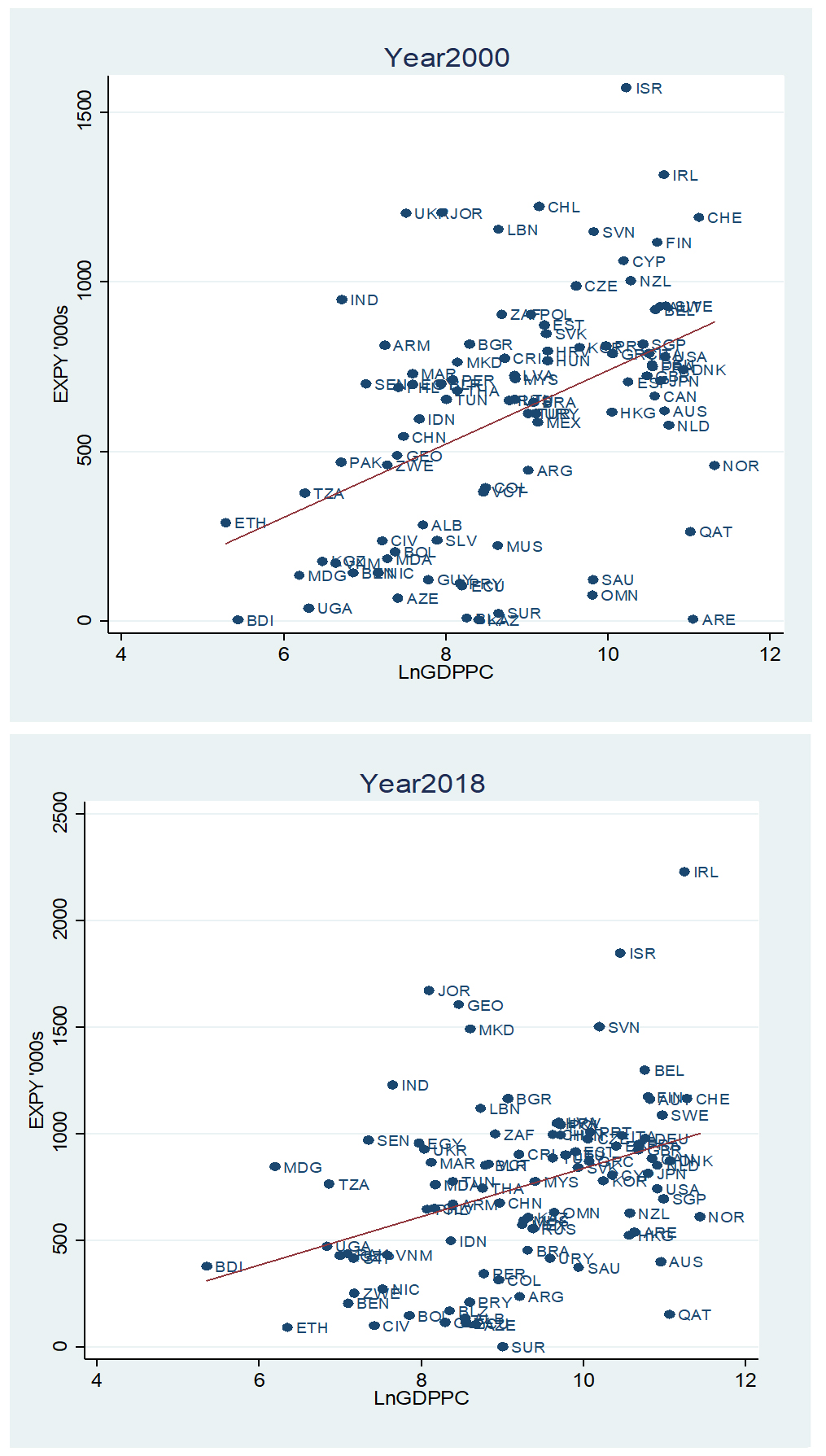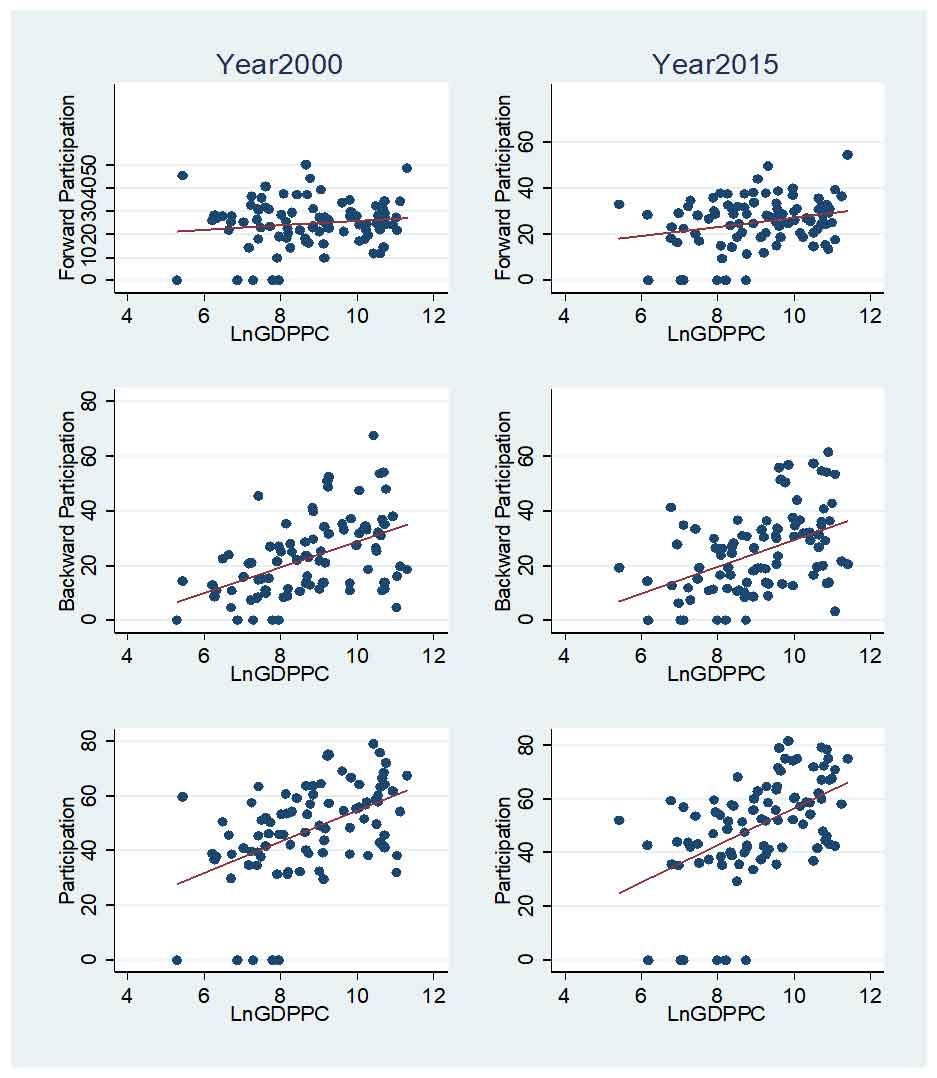While the dominance of global value chains (GVCs) in production processes is a widely accepted fact, the impact of participation in GVCs is still being explored. Using data from a sample of 100 nations for 1999-2018, this article examines the improvement in productivity brought about by GVC participation, and its role in the upgradation of intermediate exports – the main channel through which countries participate in GVCs.
Globalisation in recent years has meant an increase in the movement of goods, services, and people. Globalisation also marks the reorganisation and disintegration of production processes, wherein a good is no longer entirely manufactured in one location or country, giving rise to global value chains (GVCs). GVCs essentially imply a breakdown of the production chain into specific tasks and production processes that are no longer bound geographically but rather spread worldwide. The location of these processes is chosen to exploit the relatively cheaper factors of production. This new form of trade involves an exchange not of finished products but rather of intermediate goods and services. A study by the OECD (Organisation for Economic Co-operation and Development) finds that a large proportion of the trade among developed countries – 56% for goods and 73% for services – comprises intermediate inputs (Miroudot, Lanz and Ragoussis 2009).
While the dominance of GVCs is a widely accepted fact, the impact of participation in GVCs is still under investigation. In a recent study (Betai and Chanda 2020), we focus on the improvement in productivity brought about through GVC participation. We examine how participation in GVCs has led to an upgrading of intermediate exports – the main channel through which countries participate in GVCs. Our research spans approximately 100 countries, and we analyse their intermediate goods trade between 1999 and 2018.
Measuring productivity
Using the methodology developed by Hausmann et al. (2006), we first rank traded intermediate goods based on their ‘implied productivity’ levels, and then weigh the intermediate export basket of countries using this measure of implied productivity. The measure of implied productivity, called PRODY, is a weighted average of the per capita incomes of all countries exporting the product, where the weights used are the relative comparative advantage (RCA)1 of countries in the export of that commodity. The higher the PRODY value of a commodity, the higher is its implied productivity. This relation assumes that a good primarily produced by rich countries would be more productive/sophisticated than a good predominantly produced by low-income countries.
Using PRODY, the productivity or sophistication level associated with a country's export basket, called EXPY, is constructed. EXPY is a weighted average of the PRODYs where the weights are the product's share in a country's export basket. The sophistication index, EXPY, captures the ‘implicit productivity’ of goods2. The indices do not directly determine the intrinsic features of a commodity (for example, embedded technology, complexity, etc.) but rather infer it from the observed trade patterns.
In our study, EXPY measures the sophistication of the intermediate export basket. The distinction between intermediate goods and other goods is arrived at by using Broad Economic Category (BEC). BEC classifies all Standard International Trade Classification, Rev. (Revision) 3 (SITC) goods under three broad groups: consumption, intermediate and capital goods. We stick to only the intermediate products from SITC groups 5 to 83.
We restrict the number of countries to those for which data are available across the 20 years under consideration. Thus, we have a sample of 100 countries. The period has been restricted to 20 years – from 1999 to 2018 – even though there are data available from 1988, as the number of countries available before 1999 reduces the sample size. The data were obtained from World Integrated Trade Solution (WITS).
Ranking goods based on productivity
On ranking goods based on PRODY, we find that the bottom-ranked products are mainly textiles-based goods. This reflects the high comparative advantage that middle- and low-income (MLI) countries have in the textile industry. In the top-ranked products, we find the overwhelming presence of processed metal products such as flat-rolled iron products, magnetic tapes, tin and alloy plates, and electrical products such as phonograph records, electrical resistors, and conductors. Goods such as toys and wood-based products also among the top-ranked as some high-income (HI) countries have high RCA in them (for example, Luxembourg has high RCA in fibreboard of wood).
Excluding outlier countries4, we find that, on average, EXPY has been increasing across all income groups. Most countries in the sample have experienced an increase in EXPY values from 1999 to 2018. Only 22 out of the 100 countries show a decrease. Of the countries that registered a decrease, only four were HI countries. Additionally, we find that EXPY increases with income. Generally, it is observed that the OECD countries have performed better on average, along with countries like India and Chile (Figure 1). Israel and Iceland have been the best performers over the 20 years. In contrast, countries like Suriname, Sao Tome, and Principe have been the worst performers.
Figure 1. EXPY and log of GDP (gross domestic product) per capita

Source: (i) Authors' calculations. (ii) Data for GDP per capita were obtained from the World Bank Development Indicators dataset.
Next, we look at the three GVC participation indicators for our panel of countries: (i) forward participation (the DVX (domestic value added) content of exports as a share of total VA (value added) share), (ii) backward participation (the FVA (foreign value added) content of exports as a share of total VA), and (iii) total participation (sum of forward and backward participation)5. Plotting the indicators against the countries' GDP per capita, we find that participation increases with income. The positive slope is pronounced for backward participation while it is flat for forward participation, that is, the positive relationship between backward participation and income is stronger relative to the case of forward participation.
Figure 2. Global value chain participation indicators and log of GDP per capita, 2000-2015

Source: Authors' calculations using UNCTAD (United Nations Conference on Trade and Development)-Eora Global Value Chains Database.
Note: Log of GDP per capita data do not include outliers.
Factors affecting intermediate export sophistication
We seek to determine the effect of GVC participation and other indicators (such as, human capital, export market concentration, and foreign direct investment (FDI)), on EXPY, and find that while HI countries benefit from both backward and forward participation, MLI countries benefit only from forward participation. We attribute these differences to variations in the levels of human capital, trade and fiscal policies, and the direction of FDI flows. We also find that as countries improve their capacity to adopt latest technology, that is, as the distance from the ‘technological frontier’ reduces, the productivity of the basket increases.
By importing a larger share of intermediate goods and outsourcing production, HI countries save on production cost, redirecting it towards investment. Moreover, HI countries benefit from redeploying their workers to more sophisticated tasks. However, such redeployment requires that the workers who performed tasks that are now carried out abroad, can move on to more specialised activities. We find that HI countries do have this availability of skilled workers. HI countries also benefit from forward participation due to the transfer of technology and R&D (research and development) through FDI links with other advanced economies.
MLI countries, on the other hand, do not benefit from backward participation. We do not find evidence for the hypothesis that developing countries can improve their productivity by importing intermediate goods, thereby gaining access to embodied foreign knowledge. There are two possible reasons for this. First, MLI countries lack the required human capital to absorb information from imported products 6. Second, many low-income countries tend to be on the low-skill end of GVC participation. Kummritz and Quast (2016) show that developing countries primarily concentrate on downstream activities such as assembly of goods. This essentially means that firms in developing countries rely more on direct transfer of knowledge from lead firms, than on imports.
Developing countries, thus, derive benefit from forward participation. Forward participation implies a larger export of intermediate goods. The benefits range from an increase in specialisation to direct transfer of technology by MNEs (multinational enterprises), to learning from exporting. To integrate into the GVC as suppliers and to attract investment, developing economies must reduce trade barriers and create a suitable business environment. A 2011 report by UNCTAD notes that preferential trade policies with developed economies have been important determinants of the localisation of the emerging economies' production process. Similarly, Kowalski et al. (2015) point out that trade and investment agreements in South East Asia, North America, and Eastern Europe are linked to the proliferation of production networks in these regions.
In addition to trade policies, our study shows the importance of industrial, taxation, and other economy-wide policies in emerging economies. These include policies that focus on education, infrastructure, health, and workforce development, which enhance the quality of the workforce, build national competitiveness, and attract investors to a country. Tax incentives and structures are also included.
Since the 1990s, the flow of FDI to developing countries has increased, hinting at the possible transfer of technology to these economies. Policies such as local content requirements7 (often used by India and China), explicit requirements for technology transfer from foreign investors, and joint ventures in return for market access, are some of the many techniques used by developing countries to take advantage of knowledge transfers through FDI. However, benefits from FDI and technology transfer are not automatic. Policies that improve links between international and local firms and establish an appropriate IPR (intellectual property rights) framework are needed – alongside the earlier mentioned policies to maximise the benefits from GVCs. There is also an argument favouring vertical industrial policies (Francis 2019, Gereffi and Sturgeon 2013). Francis (2019) argues that in the absence of tariff protection in GVCs, industrial policies assume greater importance in enabling indigenous technology, crucial in extracting the benefits from GVC participation, and increased FDI and MNE presence.
Moreover, we find that backward participation has only an immediate impact on intermediate export productivity, whereas forward participation has a longer term impact. Backward participation, which essentially involves imports of intermediate goods for further production, needs the presence of vital human capital to benefit but does not require any other type of capacity-building. Conversely, forward participation requires laws, policies, and IPR systems that can enable the countries to take advantage of participation. Receiving countries and firms also need time to absorb direct and indirect technology transfer from FDI inflows. Thus, while backward participation has an immediate impact, forward participation can result in long-term benefits.
Implications for developing countries
Our findings have several policy implications for the approaches taken by developing countries like India to GVC integration. Since developing countries benefit from forward participation, which depends mainly on MNEs’ activities and is driven by profit motives, developing countries will have to ensure that their economies remain attractive for such firms. This requires that attention be paid to industrial policies and factors that improve ease of doing business. Trade agreements must be framed to encourage investment flows and facilitate the transfer of knowledge. Moreover, investments in health, infrastructure, and education, that improve national competitiveness and absorption capacity, cannot be ignored. These policies will improve the benefits that countries derive from forward and backward participation, as they improve the extent to which countries can take advantage of the knowledge embodied in intermediate imports. Furthermore, reliance on direct technology transfers by MNEs must be reduced by developing in-house innovation capacity, the building of R&D centres and a focus on STEM (science, technology, engineering, and mathematics) education.
There are, however, also threats to and from GVC participation. Rising resentment in developed countries due to outsourcing and increasing trade deficits, and the spread of automation and skill-biased technology, could cause a decline in GVC participation leading to higher unemployment and poverty in developing countries. Thus, developing countries need to be prepared for these scenarios in the near future.
In summary, our findings confirm the fact that GVC participation contributes to the sophistication of intermediate manufactured exports. However, the significance of the channels varies depending on the income level. Countries must maintain open trade and FDI policies and invest in human capital and innovation and create a conducive business environment if they are to leverage GVC participation and derive the associated benefits.
I4I is now on Telegram. Please click here (@Ideas4India) to subscribe to our channel for quick updates on our content
Notes:
- RCA is used to help assess a country’s export potential. RCA of a country for a particular good is measured as the product’s share in a country’s total exports relative to the product’s share in world trade. A value >1 indicates that the country has RCA in the commodity, that is, it has potential in the export of the commodity.
Where and are exports of good j and total exports by country i, and are exports of good j and total exports by the world. The rationale for using RCA rather than shares is to ensure that a country's size does not distort the ranking of goods.
- For more information about the indices and their calculation, please see Betai and Chanda (2020).
- Group 5 consists of chemicals, groups 6 and 8 comprise all manufactured goods, and Group 7 is made up of machinery and transport equipment.
- The six countries that consistently showed up as high-ranking outliers are Zambia, Barbados, Iceland, Luxembourg, Malta, and Gambia. The exclusion of the six outlier countries reduces the sample size to 94 countries, of which 41 are HI, and 53 are MLI countries.
- Generally, participation indices are calculated as a share of gross exports. However, the size of the export basket can often distort the participation numbers (especially if the export baskets are too big or too small). To avoid this issue, we use total VA content of exports as the base.
- In our sample, the human capital (HC) index's average value is 3.17 for HI countries, whereas it is only 2.37 for the MLI countries. This means that on average, compared to HI countries, MLI countries do not have a very skilled population.
- The OECD defines local content requirements as “policies imposed by governments that require firms to use domestically-manufactured goods or domestically-supplied services in order
Further Reading
- Betai, NV and R Chanda (2020) ‘Global Value Chain Participation and Intermediate Export Sophistication’, IIM Bangalore Research Paper No. 629.
- Casella, Bruno, Richard Bolwijn, Daniel Moran and Keiichiro Kanemoto (2019), “UNCTAD insights: Improving the analysis of global value chains: The UNCTAD-Eora Database”, Transnational Corporations, 26(3): 115-142.
- Francis, S (2019), Industrial policy challenges for India global value chains and free trade agreements, Routledge, London.
- Gereffi, G and T Sturgeon (2013), ‘Global value chain-oriented industrial policy: The role of emerging economies’, in DK Elms and P Low (eds.), Global value chains in a changing world.
- Hausmann, Ricardo, Jason Hwang and Dani Rodrik (2006), “What you export matters”, Journal of Economic Growth, 12(1): 1-25. Available here.
- Kowalski, P, J Lopez-Gonzalez, A Ragoussis and C Ugarte (2015), ‘Participation of Developing Countries in Global Value Chains: Implications for Trade and Trade-Related Policies’, OECD Trade Policy Paper No. 179.
- Kummritz, V and B Quast (2017), ‘Global value chains in developing economies’, VoxEU, 25 February.
- Miroudot, S, R Lanz and A Ragoussis (2009), ‘Trade in Intermediate Goods and Services’, OECD Trade Policy Paper No. 93.
- UNCTAD (2011), ‘Integration of developing countries in global supply chains, including through adding value to their exports’, Note by the UNCTAD Secretariat.




 26 July, 2021
26 July, 2021 





By: CHANDRAHAS DESHPANDE 27 July, 2021
Very timely and succinct. The countries like Inia should have an Integrated apptoach towards - 'Industriaaal Policy, FDI and Trade Policy'